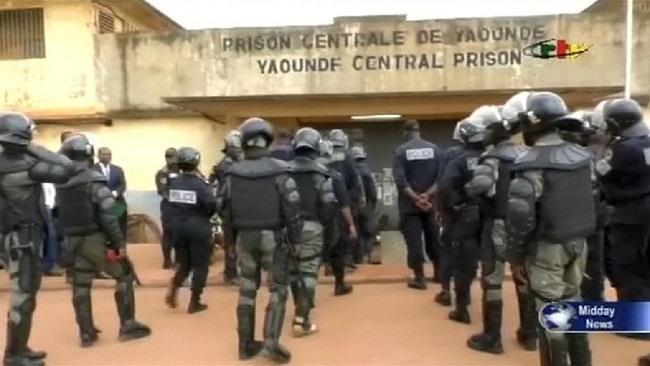Understanding the Kondengui Prison riot
Crushed inside disease-ridden cells, with no beds, little food and even less hope, inmates in Cameroon’s prisons were already tense before an influx of political detainees and Anglophone separatists stirred up an explosive mix.
At an overcrowded central prison in the capital Yaounde this week, hundreds of prisoners revolted against their poor conditions in an upsurge of violence broadcast on Facebook.
On Monday, videos spread across social media of prisoners ransacking and burning the Kondengui jail library and a sewing workshop before security forces crushed the mutiny.
Filming on their phones, inmates posted parts of their protest, chanting: “We want more to eat than porridge,” and “We want to go to trial.”
A day later, security services had reestablished control.
But the riot highlighted the crisis in the central African nation’s prisons, exacerbated by a crackdown on opposition parties, Boko Haram militants, and a separatist uprising that has rocked English-speaking regions since 2016.
“Prison overcrowding is exacerbated by the socio-political crisis that began in 2016 in the Anglophone areas and the post-election crisis,” said Maximilienne Ngo Mbe, director of the local REDHAC rights group.
“The situation in Cameroonian prisons has become catastrophic… How is it that people languish in prison for two or three years without being tried.”
The Cameroon prison population has increased steadily from 23,500 in 2013 to almost 31,000 in December 2017, according to the last report published in 2018 by the National Commission for Human Rights and Freedoms of Cameroon.
Kondengui prison, the scene of the riot, was built to accommodate 1,500 inmates but is estimated to house more than double.
Some prison occupancy rates are three times over normal capacity, according to official data.
Rights groups say prisons also suffer from a prevalence of tuberculosis, HIV, AIDS, cholera and scabies.
– Growing numbers –
Since 2017, fighting between government troops and English-speaking separatists demanding independence in two western regions has killed hundreds and forced nearly 500,000 people from their homes.
The government has rejected the demands for autonomy and cracked down on English-speaking communities which chafe at what they see as discrimination from the French-speaking majority.
Some prisons have been filled with English-speaking activists accused of militancy by the authorities, but who are yet to face trial.
In Buea, the capital of an English-speaking region, tensions erupted at a prison on Tuesday housing many separatist inmates — a day after the revolt in Yaounde.
Gunshots were heard around the prison and flame and smoke were seen rising from its roof, witnesses said.
Party chief Maurice Kamto has been held in jail in Yaounde since January after claiming the 2018 presidential election results were rigged.
The official victor — President Paul Biya, now in power for 36 years — has long sought to control the political space in the country.
Last month hundreds of opposition supporters were also arrested.
Many have been released but after the Kondengui prison riot, lawyers for MRC members still detained said several had been taken to a security force detention facility.
Human Rights Watch has warned that over the past year security forces at such facilities have “used torture without fear of repercussion.”
– Packed into cells –
Prison overcrowding is also blamed on the fight against Nigeria-based Boko Haram jihadists, which have launched numerous attacks in the country.
For years, prisons in Cameroon’s big cities have struggled, says Marie Morelle, a geographer at the University Paris 1, and specialist in the country’s prisons.
In the north of the country, the jailing of Boko Haram fighters alongside the crackdown on suspected separatist militants has accentuated overcrowding in the northern Maroua prison, she said.
The arrival of political prisoners in recent years has encouraged the expression of grievances, Morelle added.
He died of suffocation after being locked in a disciplinary cell measuring 4 metres squared and packed with 22 people.
In 2016, a riot erupted in the same prison over a lack of drinking water.
A year later in Baffoussam in the west, prisoners protested jail conditions and in Kumbo a jail was partially destroyed by a riot and fire.
Culled from InfoSurhoy





